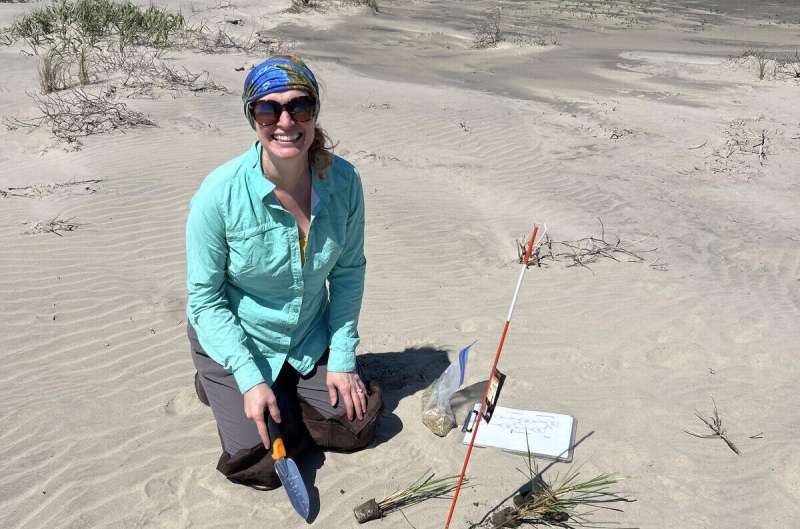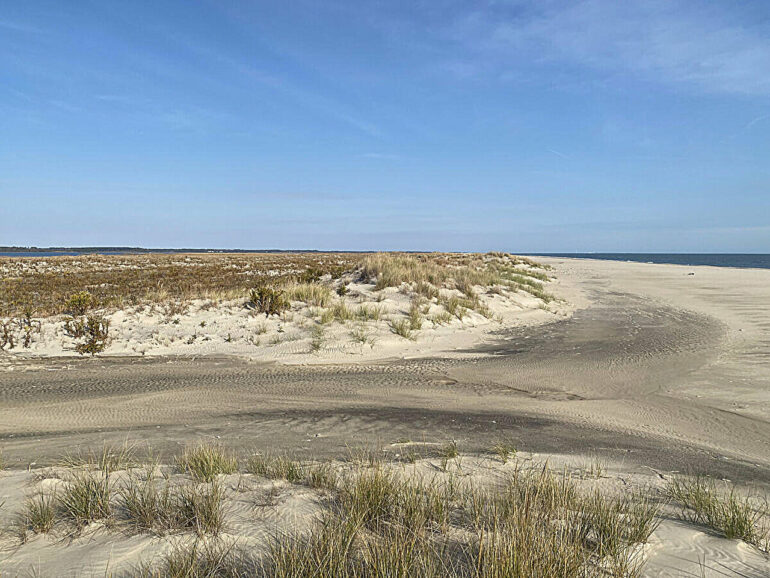Barrier islands dot the landscape along Virginia’s Eastern Shore, protecting the coastline from direct impacts of storms and sea-level rise. Made of sand, they are created and changed by environmental factors. But with climate change and human development, these natural processes can be disrupted.
Virginia Commonwealth University professor Julie Zinnert has explored how dune dynamics can affect ecosystems on adjacent interior islands. Her recent article in the journal Nature was co-authored with Alexander Sabo, who earned his master’s in biology from VCU; Max Castorani, Ph.D., associate professor of environmental sciences at the University of Virginia; and Michael Cornish, a graduate research fellow at UVA.
“Our goal was to show how different parts of the landscape are connected,” said Zinnert, Ph.D., an associate professor in the Department of Biology in the College of Humanities and Sciences.
During their research, Zinnert and her colleagues studied Hog and Metompkin, two islands on the Eastern Shore that are within the Virginia Coast Reserve and have been primarily uninhabited for generations. To understand the effects of dune dynamics, they looked at vegetation cover, sediment accretion and ease of sediment and water movement.
Zinnert spoke with VCU News about the importance of barrier islands and dunes—and why some have seen more disturbance than others.

Julie Zinnert, Ph.D., plants dune grasses, a natural dune protectant. © Julie Zinnert
In the big picture, what should we know about barrier islands—in terms of their role and the threats they face?
Here is a great recent publication by my lab on barrier islands and climate change. It is meant for children, but I have heard from many adults that it is a great resource for adults, too.
To put it simply, barrier islands are composed of sands that are constantly moving in response to the environment (winds, waves, tides). They occur along sandy and shallow sloped coastlines, and they buffer landward areas from damaging effects of storms. When sea level rates increase, natural islands respond by migrating landward.
These islands are also highly developed along much of the Atlantic and Gulf coasts in the U.S. When islands become developed, they cannot naturally respond to storms and sea-level rise by moving—they are physically fixed in space by human development, which makes them more vulnerable to disturbance.
The area where we conducted our study—the Virginia barrier islands—is unique, as these islands are largely undeveloped and are allowed to respond naturally to the changing environment. It allows us to study how these islands naturally respond to climate change drivers. This can be useful for informing how managed landscapes may change in the future.
What are your study’s major findings?
Dunes are important for determining how easily habitats landward of the dunes are disturbed from high water events such as sea-level rise, storms or high winds. These landward habitats show evidence of higher disturbance—higher soil salinity, lower soil carbon, less vegetation—when dune elevations were low compared with dunes with higher elevation.
Sediment availability provides a control on dune building (i.e., sediment accretion). We found that bitter panic grass (Panicum amarum), a common dune-building species that has expanded abundance over the last decade, accretes less sediment than the other dune-building grasses in our region, such as American beachgrass (Ammophila breviligulata) and salt meadow cordgrass (Spartina patens). This species has likely increased abundance due to warming climate in the region.
What comes next?
I work with people who model climate scenarios for barrier island change. These results are used in parameterizing models—for determining how the landscapes may evolve in the future—to predict how much carbon is stored in these islands and how that may change under different climate scenarios. I am also [working] on a couple of proposals (in preparation or in review) that aim to evaluate these future conditions along the mid-Atlantic coastline (Maryland, Virginia, North Carolina) and Gulf coasts.
More information:
Alexander B. Sabo et al, Drivers of dune formation control ecosystem function and response to disturbance in a barrier island system, Scientific Reports (2024). DOI: 10.1038/s41598-024-61741-9
Provided by
Virginia Commonwealth University
Citation:
Q&A: Barrier islands and dunes protect coastlines, but how are environmental changes affecting them and adjacent land? (2024, June 14)



